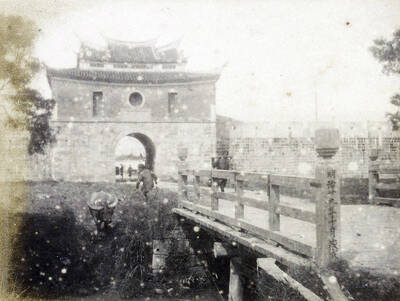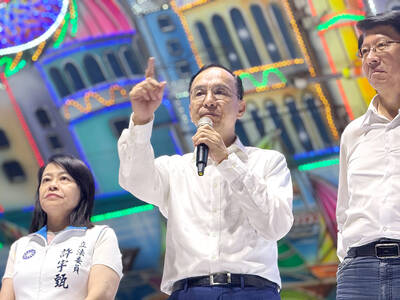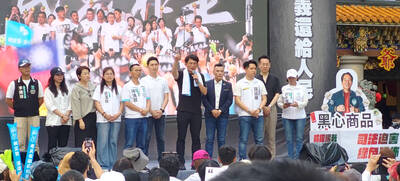There’s a jaunty rap at the door, and in bounds Michelle Yeoh. She’s on springs, despite just having arrived in London after stops in Paris, Taiwan and Hong Kong. But perhaps that’s not surprising: from her earliest action films, energy has always characterized her work.
We meet in an apartment where glossy copies of Variety magazine are strewn around us, their covers trumpeting potential Oscar contenders such as Frost/Nixon and The Reader. Yeoh, 46, is no stranger to that world. After impressing as the Bond girl Wai Lin in Tomorrow Never Dies in 1997, she went on to star in Crouching Tiger, Hidden Dragon (臥虎藏龍), Ang Lee’s (李安) Oscar-winning martial-arts love story of 2000. It was one of the biggest non-English language hits of all time. But the film she has come to discuss is more mesmerizing than most of the titles likely to be vying for Hollywood doorstops, the mesmerizing Far North, directed by the British filmmaker Asif Kapadia and shot on Svalbard, in the Arctic Ocean above Norway, the most northern settlement in the world.
Yeoh plays Saiva, who passes her days in the icy wasteland hunting animals with her companion, Anja (Michelle Krusiec), and reflecting on a life that has been cursed ever since a shaman declared she was bad juju. Wandering the plains one day, who should she find curled up on the ice but Sean Bean. Many women would consider this a boon. But once Bean has thawed out, his presence jeopardizes the women’s relationship, with unsettling consequences.
“When I got the script,” Yeoh says, “I thought: either my agent wants to kill me or he’s telling me I need a challenge.” She gives an emphatic laugh. Like all her films, Far North was hugely physically demanding.
Yeoh, who made her name as an action star in Hong Kong in the early to mid 1990s, is probably the actor of her age most likely to be found begging a director to stuff the insurers and let her perform her own stunts. While Far North might seem worlds away from movies such as Police Story 3: Supercop (警察故事3:超級警察) (memorable for one particularly awesome motorcycle leap on to a moving train), what they have in common is the sheer stamina each has required of her. Indeed it was the harsh conditions and natural hazards that attracted her to Far North, she says. But then it’s probably a breeze to work under constant threat of polar bear attack when you’ve acted alongside Vin Diesel, as Yeoh did in Babylon AD.
“On Far North, we were always aware of being at the whim of Mother Nature,” she says. “She’s the biggest star in the film. But I had always longed to go to the North Pole, and the best time to go somewhere is when you’re working on a film. You can roll up your sleeves, get to know the people. That’s what I did — I spent time with the locals, I hung out with them, soaked them up, watched how they move and sit, with their legs slightly spread, their shoulders hunched. They don’t have big gestures but their movements are basic, refined, pure.”
She says that the
role itself took her “to dark places most of us can’t get our heads around. We were all living together on a boat, an ice breaker, with all this jaw-dropping scenery around us —
all those miles and miles of nothing.”
She says that last word as if she particularly savored it. You sense that Far North, like her role in Danny Boyle’s 2007 science-fiction thriller Sunshine, came as something of a tonic after the big-budget productions she’s done — from Tomorrow Never Dies to Memoirs of a Geisha (“Two-
and-a-half hours in makeup — every day!”) to the recent Mummy threequel, Tomb of the Dragon Emperor.
“It’s so important for me to do my own stunts,” Yeoh says. “The sense of achievement is so immense. But the studios don’t want to take the risk. ‘You’re an actor, actors don’t do stunts!’ And if they do let you do anything, they wrap you in so much cotton wool it takes away the fun anyway.”
Yeoh, who was born Yeoh Chu-Kheng (楊紫瓊) to an affluent Chinese-Malay family in Ipoh, Malaysia, has always been interested in using her body to express herself. “Body language is more fascinating to me than actual language,” she says. “Before you get into the mind, you have to inhabit the physicality. Body language is a great way of speaking.”
She says she has to use her body “to help the audience overcome the fact that they are watching Michelle Yeoh — I have to rid myself of my usual mannerisms, my usual way of moving and behaving, so that they see only the role, and don’t think of, say, Crouching Tiger.”
Given that she sees her body as her prime mode of self-expression, it’s not hard to imagine the trauma she suffered at the age of 16 when her hopes of becoming a ballet dancer were dashed by a back injury. At the time she was studying at London’s Royal Academy of Dance, hoping to become a prima ballerina.
“People talk about seeing their dreams shattered, but that really happened to me,” she says. “The doctor asked me, ‘Have you ever thought of doing something other than dance?’ Suddenly it hit me: he wasn’t joking.” The principal pointed out to Yeoh that ballet was only a small part of dance, and that there were other ways for her to express physicality. Although she couldn’t carry on with her dance degree, Yeoh stayed on at the Royal Academy, studying choreography instead and graduating in 1982 with a BA in creative arts.
It is to be hoped that the kindly principal who advised her back then has since got around to renting out The Story of Stuntwoman Ah Kam (阿金的故事), released in 1996, in which Yeoh falls 5m on to her head, or Crouching Tiger, Hidden Dragon, where her limbs, muscular and graceful, move at such speed they are a constant blur.
After leaving the Academy, Yeoh returned briefly to Malaysia — just long enough for her mother to enter her into a beauty pageant. She picked up the Miss Malaysia title, seemingly the way other people pick up colds, went on to take part in Miss World (which she did not win), before this particular career trajectory was interrupted when, in Hong Kong, she caught the eye of the billionaire studio head Dickson Poon (潘迪生). He persuaded her to make commercials — she starred opposite Jackie Chan (成龍) in her first one — and then convinced her to sign a movie contract with his company, D&B Films. Poon then completed a hat trick of contractual commitment by asking Yeoh to marry him. She still expresses surprise that their wedding, in 1988, was a cover story in Hong Kong. But here’s the strange part: having launched Yeoh’s career, after they married in 1988, Poon asked her to quit acting.
Why did she agree? Yeoh explains, patiently, that she was entirely in accord with her then-husband’s wishes. “It wasn’t a hard decision because I saw marriage as a full existence. I see someone now like Emma Thompson or Kate Winslet, who can juggle their careers and their family life, but that felt beyond me then. Maybe it comes from the Asian culture, but my thinking was that I couldn’t be running around all over the world, jumping off buildings, if I was going to give my marriage 100 percent. When I choose to do something, I always give it my complete commitment. If I feel I’ve done my best, and it’s not going the way it should, then I’ll leave. That’s what I did with my marriage.” When Yeoh and Boon divorced after just over three years of marriage, she was surprised to find her stock was still high in the film industry . “No one thought I’d left for good — they were keeping my seat warm for me. So I jumped back in.”
Last year Yeoh announced her engagement to Jean Todt, the French executive director of Ferrari’s formula one team. What if he were to suggest she give up acting? “He would never do that,” she says. “He would never ask that of me. He’s very sensible and supportive. He even came out to see me during Far North. And when he wasn’t there, he sent me food packages.”
This is good news indeed. It would be a shame if Yeoh were to call time on a career in which she has punched and kicked in the face of so many industry prejudices. As an Asian woman in her mid 40s, her every appearance on screen defies mainstream cinema’s bias towards the youthful, and the Caucasian.
“I appreciate I am very blessed, so I do work my hardest when I get the opportunity,” she says. “Asian performers have always had to fight cliched roles — the Suzie Wong type, the Chinatown waitress, the Chinatown-whatever. Even 10 years ago, they were the only roles available. You would think I would’ve been working non-stop after Tomorrow Never Dies, but my next Western film wasn’t until Crouching Tiger, Hidden Dragon three years later. Why? Because no one was offering me the roles I wanted. It was still the same old stereotypes. If you look at my CV, there’s not a big repertoire. Things are getting better now, but the same problem still arises sometimes. When I told my agent I wanted to work with Danny Boyle on Sunshine, he said, ‘There’s not really a role there for an Asian face.’ But that’s the thing: I’m not an Asian face. I’m an actress. That’s what we need to overcome.”

June 9 to June 15 A photo of two men riding trendy high-wheel Penny-Farthing bicycles past a Qing Dynasty gate aptly captures the essence of Taipei in 1897 — a newly colonized city on the cusp of great change. The Japanese began making significant modifications to the cityscape in 1899, tearing down Qing-era structures, widening boulevards and installing Western-style infrastructure and buildings. The photographer, Minosuke Imamura, only spent a year in Taiwan as a cartographer for the governor-general’s office, but he left behind a treasure trove of 130 images showing life at the onset of Japanese rule, spanning July 1897 to

In an interview posted online by United Daily News (UDN) on May 26, current Chinese Nationalist Party (KMT) Chairman Eric Chu (朱立倫) was asked about Taichung Mayor Lu Shiow-yen (盧秀燕) replacing him as party chair. Though not yet officially running, by the customs of Taiwan politics, Lu has been signalling she is both running for party chair and to be the party’s 2028 presidential candidate. She told an international media outlet that she was considering a run. She also gave a speech in Keelung on national priorities and foreign affairs. For details, see the May 23 edition of this column,

The Taiwan People’s Party (TPP) on May 18 held a rally in Taichung to mark the anniversary of President William Lai’s (賴清德) inauguration on May 20. The title of the rally could be loosely translated to “May 18 recall fraudulent goods” (518退貨ㄌㄨㄚˋ!). Unlike in English, where the terms are the same, “recall” (退貨) in this context refers to product recalls due to damaged, defective or fraudulent merchandise, not the political recalls (罷免) currently dominating the headlines. I attended the rally to determine if the impression was correct that the TPP under party Chairman Huang Kuo-Chang (黃國昌) had little of a

At Computex 2025, Nvidia CEO Jensen Huang (黃仁勳) urged the government to subsidize AI. “All schools in Taiwan must integrate AI into their curricula,” he declared. A few months earlier, he said, “If I were a student today, I’d immediately start using tools like ChatGPT, Gemini Pro and Grok to learn, write and accelerate my thinking.” Huang sees the AI-bullet train leaving the station. And as one of its drivers, he’s worried about youth not getting on board — bad for their careers, and bad for his workforce. As a semiconductor supply-chain powerhouse and AI hub wannabe, Taiwan is seeing